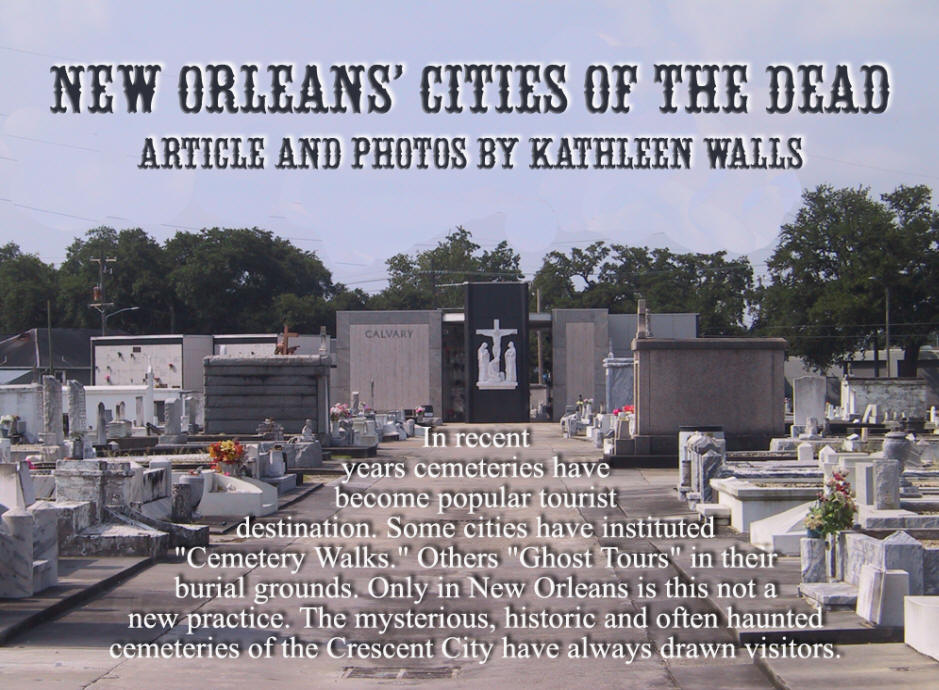
As a child
living in New Orleans, I found the cemeteries scary. I often had
to walk past the St. Vincent de Paul Cemetery on Louisa St or
the St. Roch Cemetery.
During my daylight jaunts, I might sometimes shortcut
through the cemeteries but at night, no way. In spite of my
caution I took the cemeteries for granted. They were just a part
of New Orleans. But each of the New Orleans cemeteries have a
unique and interesting history that, as an adult, I have learned
to revere.
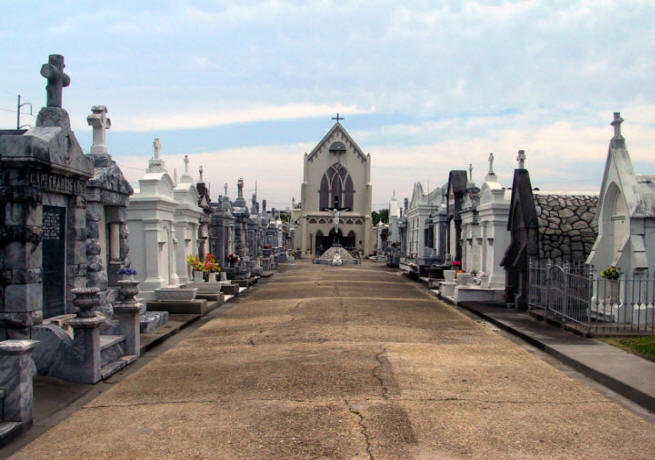 |
| The main road into St. Roch
Cemetery |
St. Roch Cemetery
St. Roch Cemetery is one of the most
unique cemeteries in a
city filled with strange cemeteries. It's genesis was
when Father Peter Leonard Thevis arrived in New Orleans in the
midst of the yellow fever epidemic of 1867.
Father
Thevis was a German priest chosen to guide the flock of
Holy Trinity Church, a
mostly German parish.
Traditionally, yellow fever took its highest toll
from the Irish, German, Italian and other emigrants who were
flooding into the city during this period.
Longtime residents had aquired more immunity to the
deadly scourge.
The death rates were believed to
average about 400 per week during these epidemics. I recall my
grandmother, who was a
preteen during the next epidemic of
1878, telling of the "Dead Wagons" who traveled down the
streets calling out "Bring out your dead."
He dumped all the bodies in the back of his wagon and
hauled them out to the cemeteries for a quick burial.
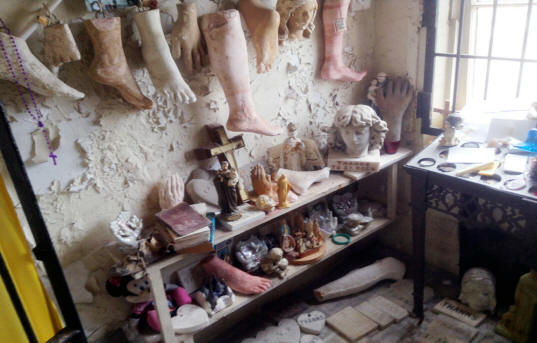 |
| "Thank You" offerings at St.
Roch |
Father Thevis prayed to St. Roch, patron saint of plague
victims, if none of
his congregation died of the dread Yellow Jack, he would build a
cemetery for his parish and a chapel to honor St. Roch.
According to coroner's
records, none of the Holy Trinity parishioners died in either
the epidemic of 1867 or 1878. Father
Theves kept that promise as evidenced by the sign above the
chapel, "Erected by Vow 1875."
Today, visitors come to see this
miraculous city of the dead. They marvel at the tombs that mimic
residences of the living. Some of the tombs are small and simple
others ornate. And there are the mausoleums, large rooms filled
with coffins, as well.
The
burials date back to the earliest day
and often are in foreign languages like the Grunder Tomb
where Franz Grunder was interred in 1877.
Some come to pray to St.
Roch for favors as they
"make" the "Stations of the Cross" carved into walls
thick enough to hold many coffins in between the life-sized
stations depicting Jesus on his way to crucifixion. Behind the
first cemetery there is a second one attesting to the many souls
"residing" here.
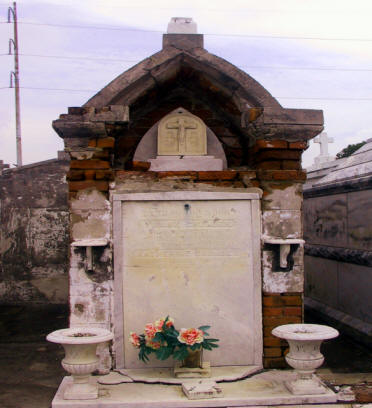 |
|
Grunder Tomb, one of the older graves |
The cemetery is said to be haunted
by a large black dog. Not unusual as St Roch was reputed
to have survived a
plague in the middle ages and was aided by his dog which is
depicted standing at the saint's side in the stature gracing the
alter of the chapel.
The cemetery is fascinating but the main
draw is the small Gothic revival chapel at the rear of the
cemetery. More specifically, one small room inside this chapel.
The room is filled with offerings of thanks to St. Roch for
cures or favors granted.
They are not the usual assortment of
flowers you might expect. There are life-like limbs, arms, legs,
hands, feet, locks of hair, prosthetics, crutches and other
objects related to the worst infirmities.
Some of the offerings are undecipherable.
But all have been left by someone who was granted a favor by the
saint. The floor is filled with bricks carved with a "Merci" or
"Thanks" engraved on them. This is a place of hope surrounded by
death.
If you find that strange, remember you
are in New Orleans.
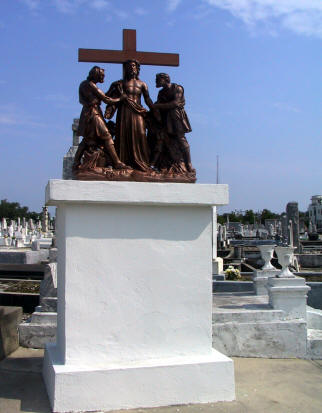 |
| Marker at the gate of St.
Patrick #1 |
St. Patrick Cemeteries
Germans weren't the only emigrants
filling the Crescent City back in that era. Irish sought refuge
from the Potato Famine and the many other problems faced in the
Emerald Isle. There are
three St. Patrick Cemeteries all located near one another at the
foot of Canal Street near City Park Ave.
The Irish built their first cemetery in
1841 and naturally named it for their patron saint.
I visited it many times
as a child and found it a peaceful place. It's where my family
is interred. St Patrick No. 2 and No. 3 followed shortly after.
Unlike the Germans of Holy Trinity
Parish, the Irish were severely decimated by the yellow fever
epidemics. In just one month, August 1853,
11,000 people were laid to rest in the St. Patrick
Cemeteries, most in St. Patrick
No. 1.
This accounts for the vast number of
just-above-the-ground graves there. Possibly it also
accounts for the ghost stories of moans heard near the rear wall
of the cemetery at night even over the sounds of traffic. The
other ghost story told about this cemetery is of a white haired
woman who follows visitors around the cemetery warning them to
be respectful, a rull all of us should follow when visitng
any cemetery.
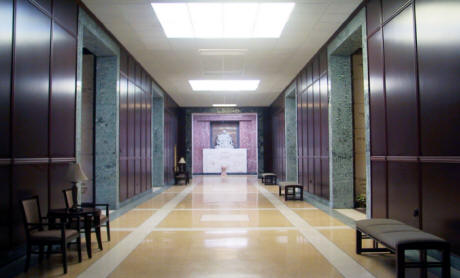 |
| One of the many mausoleums at
Metarie Cemetery |
Lake Lawn Metairie
Cemetery
The Lake Lawn Metairie Cemetery rambles across what was once the
site of the Metairie Racetrack and Jockey Club. Like much of New
Orleans society, they kept membership among the old Creole
families and refused
membership to American millionaire, Charles Howard , in the mid
19th century. Howard swore revenge and claimed he would "bury
the track and the club."
The Civil War shut the
track and club down temporarily and Reconstruction drove it to
the verge of
bankruptcy. Thus In l872, Howard was able to fulfill his vow and
buy the track and club and turn it into a cemetery for the
richest of New Orleans citizens.
Howard's eternal resting place is one of the cemetery's most
ornate mausoleums guarded by a statue of a man holding a finger
to his lips to indicate respectful silence for those who rest
here.
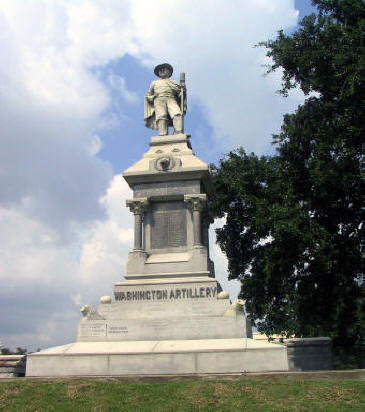 |
| Washington Artillery Tomb |
The cemetery's most
famous "resident" is General P.T.G. Beauregard who is interred
in the Army of Tennessee section.
(See Museums and
Civil War Trail for
more about Beauregard)
When I visited here, it was not like walking among a
"city of the dead" it was more like a Las Vegas for the
well-to-do deceased filled with elaborate mausoleums resembling
ornate hotels.
Along with the many mausoleums, there are several group
tombs where members of a specific group or society are buried.
I
walked for blocks and never saw another living person. Just
those rows of beautifully decorated mausoleums. It was kind of
spooky.
Speaking of spooks, legend says that a 19th century police chief
named David Hennesey, who had been murdered in 1890 supposedly
by a group of 19
Italian men.
Reportedly Hennesy guards the cemetery. The Italians were found
"not guilty" and an enraged mob broke 11 of them out of jail and
lynched them in retaliation. This was when the word "Mafia"
entered into common usage in the United States.
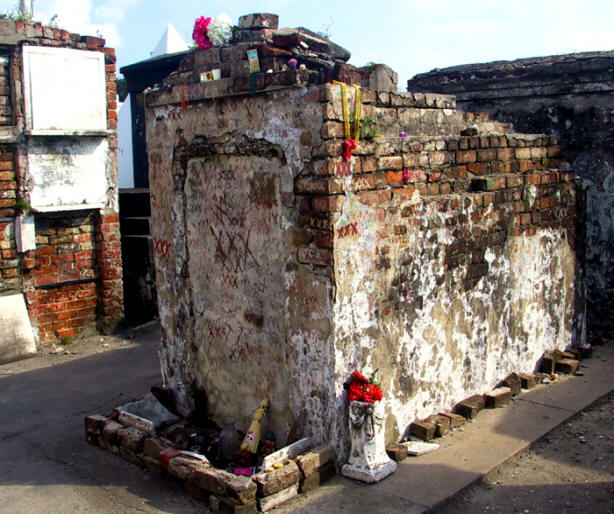 |
Not Marie Laveau's tomb but
judging by the Xs and
offerings another respected
Voodoo personage |
St. Louis Cemetery
No. 1
Perhaps I've saved the best for last. St.
Louis No. 1 is the oldest existing cemetery in New Orleans and
the fourth built in the city. It dates back to the late 1700s.
It was divided into sections for Catholics, non-Catholics, and
Negroe slaves. The gens de couleur libres (Free People of
Color) were buried with whites in the section designated for
whichever religion they practiced. Yes, I know New Orleans old
customs are confusing to the modern world.
The tombs bear the names of many of
prominent old Creole families. Bernard
de Marigny, who introduced the
game of craps to the United States; Paul Morphy, renowned
chess champions and
Delphine LaLaurie, infamous for her torture and murder of her
slaves; and in modern times, Mayer Dutch Morial, the first
African American mayor of New Orleans. are interred there.
Burials are still being allowed in the
old cemetery. Nicolas Cage has purchased a plot and had a ornate
tomb resembling a pyramid constructed for his final resting
place.
Perhaps the most infamous and most visited tomb is the one
reputed to be the final resting place of Marie Laveau,
the Glapion family crypt.
I use "resting place" lightly as it is reputed that her spirit
roams the cemetery
along with that of a black cat a dog,
the Voodoo serpent Loa,
Damballa, and many unknown spirits.
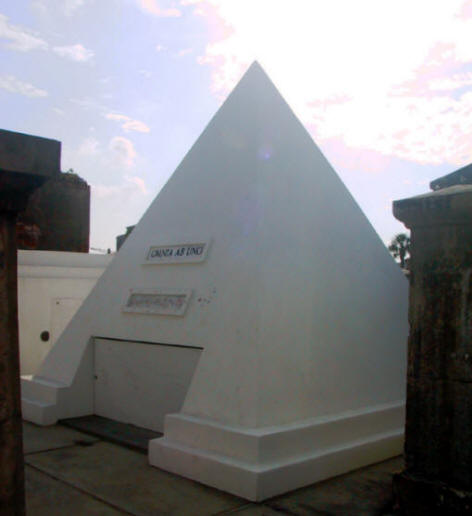 |
| Nicholas Cage's tomb |
Devotees of Voodoo
visit her tomb and place gifts at it to thank her for
favors received. They also make three Xs on it and turn around
three times to have a wish granted. Recently, the city passed a
law making it a crime to mark her grave or any of the others in
the cemetery with an X. (for
more on Voodoo click here)
Several other graves are similarly marked
and gifted. Perhaps more recent voodoo priestesses who are also
recognized by modern day practitioners of the old religion.
Another common custom, not only in St. Louis Cemetery, but in
many others is the leasing of gifts, such as Mardi Gras beads,
doubloons and other trinkets, on loved ones' graves as a love
offering.
As you might guess, St. Louis No. 1 is a
scary place. No, not because of the ghosts. They can't hurt you.
It's because of its location next to the former Iberville
Housing Project which is not the safest neighborhood in the
city. When I visited early in the day--it closes at 3PM--I hid
my purse and other valuables and locked the car taking only my
one camera and a wallet with my phone and a bit of cash.
Unfortunately, I was too cautious with what I left locked up, my
purse held my car keys. Fortunately, I hide a spare under the
car so I had to scramble around on the ground retrieving the key
to open my locked car.
All went well and I enjoyed my visit to
these old "Cities of the Dead." I only wished I had more time to
visit the forty or so other cemeteries that help tell the
history of this mysterious old city.
One good way to peep into these mystical places is on
a
Voodoo and Cemetery Tour.
|